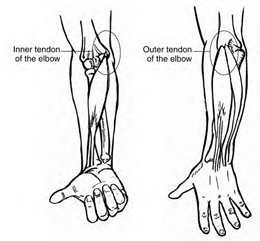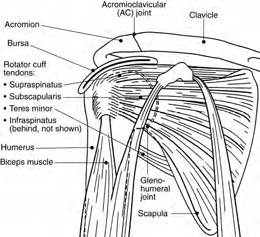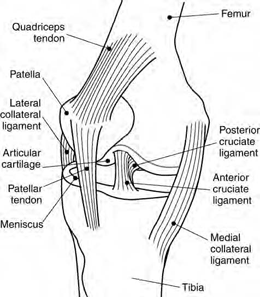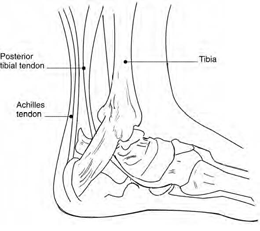bursitis and tendinitis

Figure 1. Tennis elbow and golfer's elbow. Tennis elbow refers to an injury to the outer elbow tendon. Golfer's elbow is an injury to the inner tendon of the elbow. These conditions can also occur with any activity that involves repetitive wrist turning or hand gripping, such as tool use, hand shaking, or twisting movements. Carpenters, gardeners, painters, musicians, manicurists, and dentists are at higher risk for these forms of tendinitis. Pain occurs near the elbow, sometimes radiating into the upper arm or down to the forearm. Another name for tennis elbow is lateral epicondylitis. Golfer's elbow is also called medial epicondylitis..

Figure 2. Shoulder tendinitis, bursitis,
and impingement syndrome.
Two types of tendinitis can affect the shoulder. Biceps tendinitis
causes pain in the front or side of the shoulder and may travel down
to the elbow and forearm. Pain may also occur when the arm is raised
overhead. The biceps muscle, in the front of the upper arm, helps
stabilize the upper arm bone (humerus) in the shoulder socket. It
also helps accelerate and decelerate the arm during overhead movement
in activities like tennis or pitching.
Rotator cuff tendinitis causes shoulder pain at the tip of the shoulder
and the upper, outer arm. The pain can be aggravated by reaching,
pushing, pulling, lifting, raising the arm above shoulder level, or
lying on the affected side. The rotator cuff is primarily a group
of four muscles that attach the arm to the shoulder girdle/shoulder
blade. The rotator cuff attaches the arm to the shoulder joint and
allows the arm to rotate and elevate. If the rotator cuff and bursa
are irritated, inflamed, and swollen, they may become compressed between
the head of the humerus and the acromion,
the outer edge of the shoulder blade. Repeated motion involving the
arms, or the aging process involving shoulder motion over many years,
may also irritate and wear down the tendons, muscles, and surrounding
structures. Squeezing of the rotator cuff is called shoulder impingement
syndrome.
Inflammation caused by rheumatoid arthritis may cause rotator cuff
tendinitis and bursitis. Sports involving overuse of the shoulder
and occupations requiring frequent overhead reaching are other potential
causes of irritation to the rotator cuff or bursa, and may lead to
inflammation and impingement.

Figure 3. Knee tendinitis or jumper's knee.
If a person overuses a tendon during activities such as dancing, cycling,
or running, it may elongate or undergo microscopic tears and become
inflamed. Trying to break a fall may also cause the quadriceps
muscles to contract and tear the quadriceps tendon above the kneecap
(patella) or the patellar tendon below
it. This type of injury is most likely to happen in older people whose
tendons tend to be weaker and less flexible. Tendinitis of the patellar
tendon is sometimes called jumper's knee because in sports that require
jumping, such as basketball, the muscle contraction and force of hitting
the ground after a jump strain the tendon. After repeated stress,
the tendon may become inflamed or tear.
People with tendinitis of the knee may feel pain during running, hurried
walking, or jumping. Knee tendinitis can increase risk for ruptures
or large tears to the tendon. A complete rupture of the quadriceps
or patellar tendon is not only painful, but also makes it difficult
for a person to bend, extend, or lift the leg; or to bear weight on
the involved leg..

Figure 4. Achilles tendinitis.
Achilles tendon injuries involve an irritation, stretch, or tear to
the tendon connecting the calf muscle to the back of the heel. Achilles
tendinitis is a common overuse injury, but can also be caused by tight
or weak calf muscles or any condition that causes the tendon to become
less flexible and more rigid, such as reactive arthritis or normal
aging.
Achilles tendon injuries can happen to anyone who regularly participates
in an activity that causes the calf muscle to contract, like climbing
stairs or using a stair-stepper, but are most common in middle-aged
"weekend warriors" who may not exercise regularly or take time to
warm up and stretch properly before an activity. Among professional
athletes, most Achilles injuries seem to occur in quick-acceleration
or jumping sports like football, tennis, and basketball, and almost
always end the season's competition for the athlete.
Achilles tendinitis can be a chronic condition. It can also cause
what appears to be a sudden injury. Tendinitis is the most common
factor contributing to Achilles tendon tears. When a tendon is weakened
by age or overuse, trauma can cause it to rupture. These injuries
can be so sudden and agonizing that they have been known to bring
down charging professional football players in shocking fashion..
Bursitis and tendinitis are both common conditions that involve inflammation of the soft tissue around muscles and bones, most often around the joints of the shoulder, elbow, wrist, hip, knee, or ankle.
A bursa is a small, fluid-filled sac that acts as a cushion between a bone and other moving parts: muscles, tendons, or skin. Bursae are found throughout the body. Bursitis occurs when a bursa becomes inflamed (redness and increased fluid in the bursa).
A tendon is a flexible band of fibrous tissue that connects muscles to bones. Tendinitis is inflammation of a tendon. Tendons transmit the pull of the muscle to the bone and thereby cause movement. They are found throughout the body, including the hands, wrists, elbows, shoulders, hips, knees, ankles, and feet. Tendons may be small, like those found in the hand, or large, like the Achilles tendon in the heel.
Causes
Bursitis is commonly caused by overuse or direct trauma to a joint. Bursitis may occur at the knee or elbow; for example, from kneeling or leaning on the elbows longer than usual on a hard surface. Tendinitis is most often the result of a repetitive injury in the affected area. These conditions occur more often with age. Tendons become less flexible with age, and therefore, more prone to injury.
People such as carpenters, gardeners, musicians, and athletes who perform activities that require repetitive motions or place stress on joints are at higher risk for tendinitis and bursitis.
An infection, arthritis, gout, thyroid disease, and diabetes can also bring about inflammation of a bursa or tendon.
What parts of the body are affected?
Tendinitis causes pain and tenderness just outside a joint. Some common names for tendinitis identify with the sport or movement that typically increases risk for tendon inflammation. They include tennis elbow, golfer's elbow, pitcher's shoulder, swimmer's shoulder, and jumper's knee. Some common examples follow.
Diagnosis
Diagnosis of tendinitis and bursitis begins with a medical history and physical examination. The patient will describe the pain and circumstances in which pain occurs. The location and onset of pain, whether it varies in severity throughout the day, and the factors that relieve or aggravate the pain are all important diagnostic clues. Therapists and physicians will use manual tests called selective tissue tension tests to determine which tendon is involved, and then will palpate (a form of touching the tendon) specific areas of the tendon to pinpoint the area of inflammation. X-rays do not show tendons or bursae, but may be helpful in ruling out problems in the bone or arthritis. In the case of a torn tendon, X-rays may help show which tendon is affected. In a knee injury, for example, an X-ray will show that the patella is lower than normal in a quadriceps tendon tear and higher than normal in a patellar tendon tear. The doctor may also use magnetic resonance imaging (MRI) to confirm a partial or total tear. MRIs detect both bone and soft tissues like muscles, tendons and their coverings (sheaths), and bursae.
An anesthetic-injection test is another way to confirm a diagnosis of tendinitis. A small amount of anesthetic (lidocaine hydrochloride) is injected into the affected area. If the pain is temporarily relieved, the diagnosis is confirmed.
To rule out infection, the doctor may remove and test fluid from the inflamed area.
Who treats these conditions?
A primary care physician or a physical therapist can treat the common causes of tendinitis and bursitis. Complicated cases or those resistant to conservative therapies may require referral to a specialist, such as an orthopaedist or rheumatologist.
Treatment
Treatment focuses on healing the injured bursa or tendon. The first step in treating both of these conditions is to reduce pain and inflammation with rest, compression, elevation, and anti-inflammatory medicines such as aspirin, naproxen (Naprosyn, Aleve), or ibuprofen (Advil, Motrin, or Nuprin). Ice may also be used in acute injuries, but most cases of bursitis or tendinitis are considered chronic, and ice is not helpful. When ice is needed, an ice pack can be applied to the affected area for 15-20 minutes every 4-6 hours for 3-5 days. Longer use of ice and a stretching program may be recommended by a health care provider.
Activity involving the affected joint is also restricted to encourage healing and prevent further injury.
In some cases (e.g., in tennis elbow), elbow bands may be used to compress the forearm muscle to provide some pain relief, limiting the pull of the tendon on the bone. Other protective devices, such as foot orthoses for the ankle and foot or splints for the knee or hand, may temporarily reduce stress to the affected tendon or bursa and facilitate quicker healing times, while allowing general activity levels to continue as usual.
The doctor or therapist may use ultrasound (gentle sound-wave vibrations) to warm deep tissues and improve blood flow. Iontophoresis may also be used. This involves using an electrical current to push a corticosteroid medication through the skin directly over the inflamed bursa or tendon. Gentle stretching and strengthening exercises are added gradually. Massage of the soft tissue may be helpful. These may be preceded or followed by use of an ice pack. The type of exercises recommended may vary depending on the location of the affected bursa or tendon.
If there is no improvement, the doctor may inject a corticosteroid medicine into the area surrounding the inflamed bursa or tendon. While corticosteroid injections are a common treatment, they must be used with caution because they may lead to weakening or rupture of the tendon, especially weight-bearing tendons such as the Achilles (ankle), posterior tibial (arch of the foot), and patellar (knee) tendons. If there is still no improvement after 6-12 months, the doctor may perform either arthroscopic or open surgery to repair damage and relieve pressure on the tendons and bursae.
If the bursitis is caused by an infection, the doctor will prescribe antibiotics.
If a tendon is completely torn, surgery may be needed to repair the damage. After surgery on a quadriceps or patellar tendon, for example, the patient will wear a cast for 3-6 weeks and use crutches. For a partial tear, the doctor might apply a cast without performing surgery.
Rehabilitating a partial or complete tear of a tendon requires an exercise program to restore the ability to bend and straighten the knee and to strengthen the leg to prevent repeat injury. A rehabilitation program may last 6 months, although the patient can return to many activities before then.
Prevention
To help prevent inflammation or reduce the severity of its recurrence:


